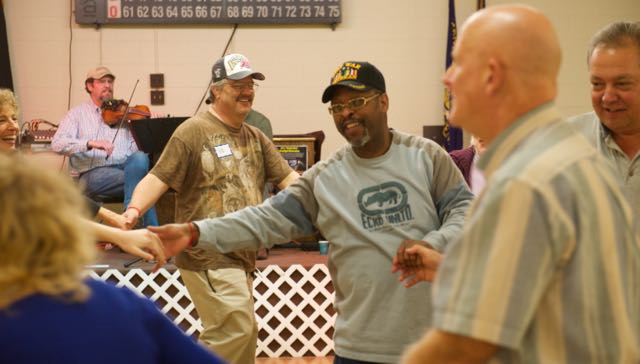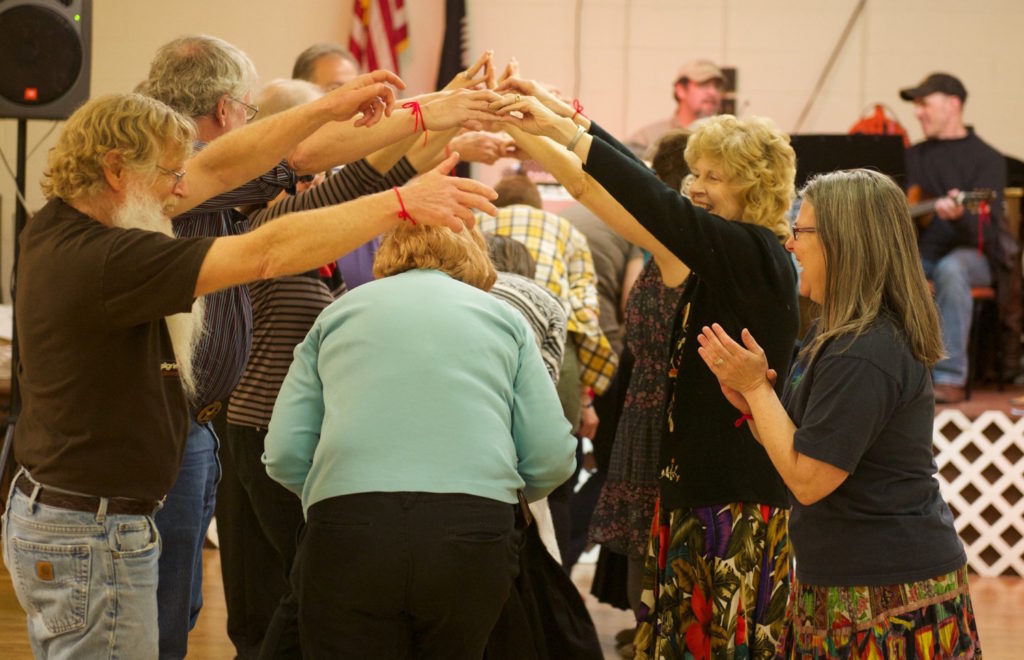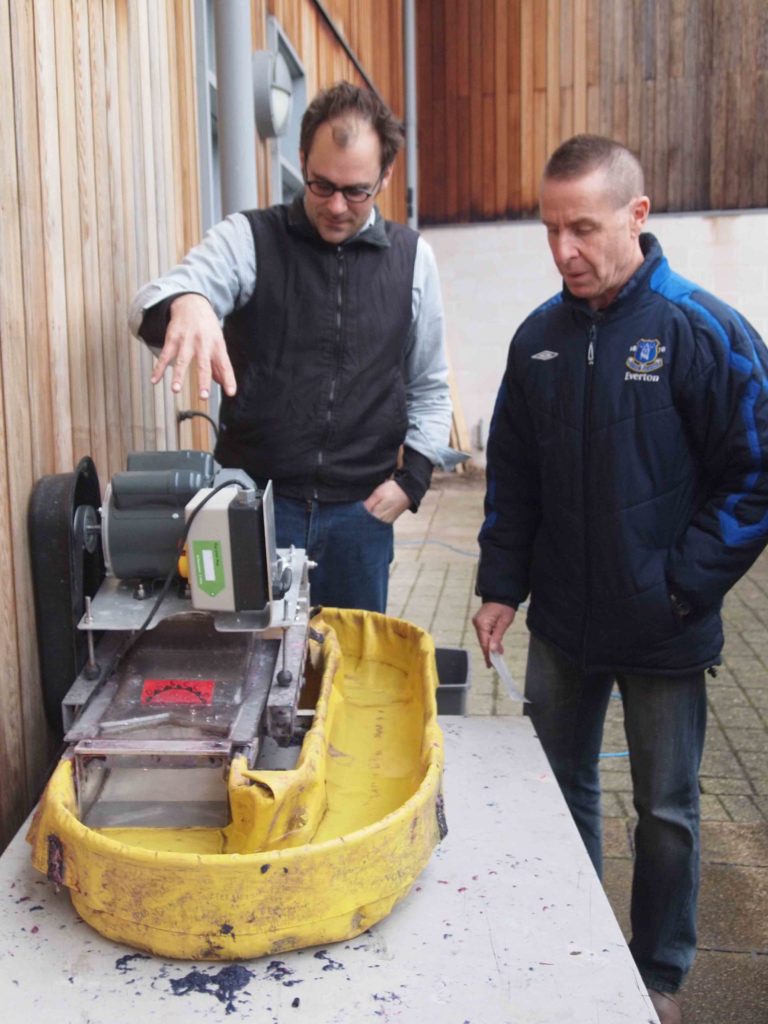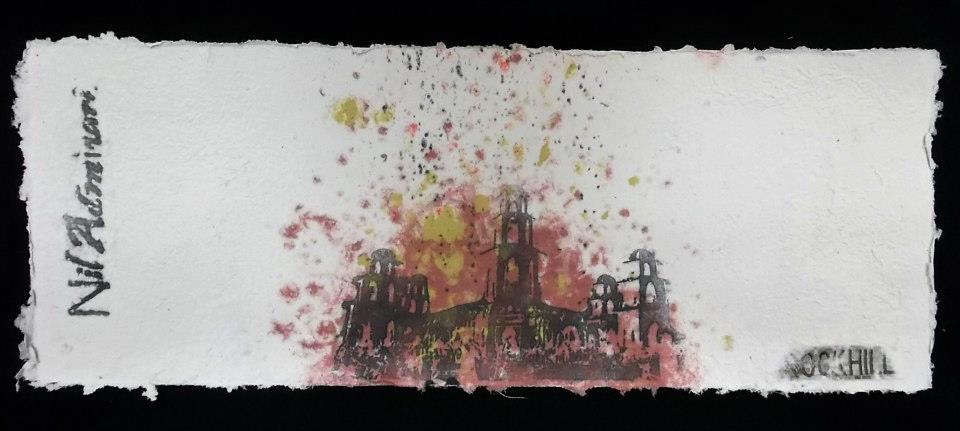Art programs help veterans create new memories
This is the second of a two-part feature on art and veterans. Read first story here.
For people who have experienced physical, mental, and emotional trauma, creating art can be a way to express the pain and a way to escape it.
“Art can be that purgative kind of thing, where we get our feelings out on paper, like journaling,” says military veteran and therapist Gerry Rice, “or it can be a distracting kind of thing. Let’s seize onto something beautiful, let’s create something.”
Rice served in Vietnam as a scout dog handler from 1969 to 1970, and is now a licensed marriage and family therapist. Though he is not certified as an art therapist, he both participates in and provides therapeutic support to an art program for veterans in California’s Antelope Valley, provided by the organization Vets 4 Veterans.
Soldiers who serve in combat are vulnerable to physical wounds, including traumatic brain injury and chronic pain, and to the mental and emotional trauma that can lead to post-traumatic stress and associated challenges including depression and substance abuse. Researchers and clinicians also increasingly recognize what is known as moral injury — shame, guilt, anxiety, and anger that result when moral and ethical beliefs and expectations are transgressed.
“Sometimes the warrior feels like, it’s not just that I was traumatized by people trying to kill me; I’m traumatized by what I feel I have become,” says Rice.
The regimented nature of military life can also make it difficult to process or express those complex emotions. “When someone asks you how you’re doing, you’re supposed to say ‘Good to go.’ You don’t get reflective, you don’t look at the humanity of the enemy, you don’t get philosophical about war,” Rice says. “You know, ‘Sounds like a personal problem, Rice. Why don’t you go see the chaplain and get your card punched?’”
A jarring return to the civilian world adds to the emotional challenges for veterans as well. Rice notes that everyday life can feel trivial compared with “the urgency of the mission that transcended all the other mundane things.”
One of the values of activities like painting and drawing, he explains, is that they provide new memories to replace those that cause veterans to relive trauma.
“You hear the phrases: ‘When were you in the war?’ ‘Last night,’ Rice says.
That trauma will never really go away, but “we’re trying to get them to feel appropriately distanced from their experience and embracing new experiences,” he says. “Putting something out there where they can be creative and expressive… or they can be creating pastoral scenes that are completely unrelated to the war experience, but putting something new and creative in that short-term memory spot.”
Rice serves patients through the Antelope Valley Vet Center in Palmdale, California, where his work with veterans is supported by the Department of Veterans Affairs. While counseling a group there, he began talking about the concept of altruism, and the power of healing by helping others. Inspired by the idea, members of that group decided to form Vets 4 Veterans, led by Tom Hilzendeger. The organization’s mission, Rice says, is “no more complicated than ‘Let’s help vets live better lives.’”
Vets 4 Veterans offers help for immediate needs such as utility bills and temporary housing, and funds scholarships for veterans through Antelope Valley College. They also operate a grant-funded therapy program, through which Rice provides services for veterans who don’t qualify to be seen through the Vet Center.
The art therapy program started in February of this year, taught by artists Steve Ponting and Ramon Ramirez; Ponting is a combat veteran who served in Vietnam. Participants learn techniques for painting with acrylics and pastels, and study the work of artists like Cezanne and Degas.
Much of Rice’s therapy focuses on helping veterans “live well” or “live better” with PTSD — a framing he got from one of his own VA counselors. He sees the success of the art therapy program in the participants’ enthusiasm for the act of creation, even though many of them had never made art before.
“They’re carrying their portfolios and their pastels and their paints, and they’re talking about brush textures,” Rice says. “There’s this new aspect in their life, this new interest, and it’s creative; it’s not destructive. … We’re adding new pages to the story.”
Veterans and their families dance for joy
Dancing Well: The Soldier Project, based in Louisville, Kentucky, is another organization that seeks to create new, joyful memories for the veterans who participate. Founder and executive director Deborah Denenfeld is a dance educator and scholar of contra dance, a type of American folk dance. In 2011, she was contacted by a psychiatrist at Fort Knox and invited to host dance sessions with his patients, who were active-duty military undergoing treatment for post-traumatic stress and traumatic brain injury.
Denenfeld worked to create a program tailored to the patients’ needs and abilities, and hosted ten sessions with them and their families. Participants reported that dancing “improved their mood, improved their relationships within the family, improved their self-confidence and their outlook on the future, reduced depression,” Denenfeld says. “Fifty percent reported a reduction in physical pain level.”

Denenfeld began organizing Dancing Well as an independent program in 2013. The organization hosts social, recreational dances for veterans and their families, and is intentional about making everyone who attends feel comfortable and safe. In contrast with a typical public dance, Denenfeld explains, activities and instruction are aimed at the individual with the most limitations: “The goal is that at the end of every single dance, every person will feel that they were successful and are uplifted.”
When people sign up for an evening of dance, they must speak with Denenfeld on the phone so she can tell them what to expect and get a sense of their needs. Events are held in neutral locations, outside of VA facilities. Each evening is filled with volunteers who help create a “party atmosphere” while welcoming and assisting participants. Dance steps are modified to eliminate swinging around or quickly changing direction, because some participants get dizzy easily. Amplified sound must be loud enough for people with hearing loss, but not too loud.
Denenfeld is vigilant about potential triggers for veterans who have experienced trauma, but knows that she may not be able to prevent them all. “They face challenges every day in their daily life, and it takes great courage for them to seek any new experience,” she says of Dancing Well’s participants.
Working with family members is also an important part of the program. Dancing infuses joy and fun that can help rebuild veterans’ relationships with their partners and children. “When a loved one has a real debilitating social-emotional issue, you never know what you’re going to face in the next minute,” Denenfeld says. “So for the family members to come to a place where it’s joy, and let’s have some fun together, and let’s be silly together, and we really care about you, and how about a big hug… These people need that in their life so badly.”

Earlier this year, Dancing Well was the subject of a study by researchers from Western Connecticut State University, and they plan to hold more studies with veteran populations around the country. Preliminary findings show that the program is particularly effective at increasing veterans’ feelings of social connectedness, says Denenfeld.
She remembers one veteran in particular who “blossomed” through being part of Dancing Well. Before, he had separated from his wife and was isolating from his children and grandchildren. Denenfeld says that he told her “he thought about suicide all the time.”
The first time he attended a dance, “from the moment he walked in the door, I watched this transformation of becoming open and then smiling and then grinning, and then it was like a different person,” Denenfeld says.
As dancing opened him to new interaction and joy, he recommitted with his counselor to therapeutic work that made deep healing possible, Denenfeld says. He stopped considering suicide, became a volunteer in suicide prevention for veterans, and reunited with his family. Though Dancing Well is not formal art therapy, his story is an example of the program’s ability to complement formal mental health treatment.
Processing the past with Peace Paper
Peace Paper Project is another organization whose work with veterans serves as a gateway to deeper therapy. In Peace Paper’s Veteran Paper Workshops, participants use traditional hand papermaking processes to transform their uniforms and/or other items representing their time in the military into blank sheets of paper. They can then write, print images, and otherwise create art using the paper they’ve made.
Peace Paper functions as art therapy, social advocacy, and fine art, explains founder and director Drew Matott. They collaborate directly with recreational and art therapists to design programs, often working within the VA hospital system or with university veterans’ centers. Peace Paper’s workshops also raise awareness of issues that affect the people they serve. Besides veterans, they work with any survivors of war and terrorism, as well as of sexual trauma and domestic violence.

Matott experienced the power of papermaking firsthand in college, where he learned that it was possible to make paper by pulping rag material from old clothing. He had the idea of honoring his father, who had died when Drew was young, by transforming his clothes into paper, and then printing a book of his photos and writing. Creating the paper gave the family an opportunity to share stories and process their loss together. The finished book became a cherished artifact for Drew’s uncle, his father’s brother. Both had been drafted for the Vietnam War, and his uncle served while his father became an anti-war activist.
“I realized that papermaking was something more than just a surface to print on,” Matott says. “The process of making paper has the ability to have profound and positive impact on people’s lives, by getting them involved in making it and sharing a story through it.”
Matott began leading papermaking workshops for veterans when he co-founded Combat Paper with Drew Cameron, an Army veteran who served in Iraq, in 2007. Combat Paper worked closely with Iraq Veterans Against the War, and became a creative outlet for veterans to express unhappiness with their time in the service and criticism of specific policies and decisions. Matott began hearing from veterans who were interested but not necessarily anti-war, and he was also learning more about art therapy and its relevance to papermaking. He decided to leave Combat Paper (which continues to operate), and founded the Peace Paper Project in 2011 with the specific goal of collaborating with art therapists.
For a typical veteran workshop, participants are asked to bring a uniform and/or other items representing their military service. Peace Paper also has donated uniforms on hand if veterans don’t want to cut theirs up. The workshops start with each person identifying themselves and their branch of service, and then talking about their uniform, telling a story, pointing out a stain or pulling a cigarette from a pocket. Then they begin to cut their uniforms into small pieces.
“You can see it — people kind of staring at the uniform with the scissors in their hand, and just looking at it. And it’s really quiet,” Matott says. “And then you start to hear the snipping, and people will start cutting. And then you start hearing the tearing, and people are tearing the seams out and pulling. Things start moving a lot more quickly. And the sounds, people start talking and telling stories, and it becomes much more of a social environment.”
The veterans next take turns pulping their uniform fabric. Peace Paper uses a piece of equipment called a Hollander beater, which circulates water; participants can actually put their fingers in the water and feel the rag material as it transforms. Next, they learn how to pull sheets of paper, and then how to add pigment and decorative elements. All the while, Matott says, they’re getting to know one another and gaining confidence in their ability to create.

Peace Paper has established more than 35 independently owned and operated studios around the world. For Matott, it’s important to root each program firmly in its community, making it sustainable beyond the initial contact with Peace Paper.
And Peace Paper participants, says Matott, are “left with a network of people, whether it’s their therapist or their community or their mental health provider, that they can continue to work with and continue to process. They’re not left totally opened up and vulnerable, which these processes can do.” Similarly, Dancing Well’s Deborah Denenfeld requires that participants be working with a mental health provider outside of the organization.
Arts programs can also raise awareness of issues that affect veterans. Through working with survivors of trauma, Peace Paper’s Matott says he has seen how the experience of people in the military can reverberate throughout communities.
“It’s part of the common thread that all of us, civilians and veterans, have to bear,” Matott says. “It’s not just when the veterans come home, but it’s also when they’re going, when they’re deployed, the decisions that we make, by the politicians and the community members, how we support them and how we don’t support them.”
Therapist Gerry Rice sees great power in the work of writers, filmmakers, and other artists who act as “witnesses,” sharing the truth of war with the general public. It’s important, Rice says, to recognize the contributions and values that servicemembers and veterans offer to society. “There’s commitment, loyalty, honor, duty, sacrifice,” he says. “They’re not just broken; they bring a whole lot more to the table than their brokenness.”
You can visit the websites of Vets 4 Veterans, Dancing Well: The Soldier Project, and the Peace Paper Project to learn more about their work, and browse arts programs for veterans all around the country in the National Initiative for Arts & Health in the Military’s directory at Americans for the Arts.

This was a wonderful article to read. Art therapy is so effective in many cases and it’s great to see it being applied to veterans who suffer from mental and emotional health issues. As a soldier, I like to research and read up on issues regarding mental health and substance abuse as I know many who struggle.
I came across this article from my research that I feel might be helpful if anyone wants to read it: https://oceanbreezerecovery.org/blog/veteran-addiction-part-1/